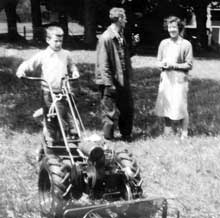Time to Mow
As April turns to May, apple blossoms follow forsythia and it's time to mow the lawn. When I was growing up, lawn mowers were made of cast iron and had to be pushed. When I was seven, my parents bought an old house whose lawn had grown to hay. Instead of a real lawn mower Dad bought a Simplicity garden tractor, complete with cultivator, snow plow, weed cutter, cordwood saw and, most important, sickle bar. Until our wilderness was tamed that sickle bar was our only mower.
Eventually it was supplanted by a succession of rotary mowers, all of which had to be followed on foot. I longed for a riding machine, like my cousin's Tiger tractor, the Beaver that cut the lawn at my school, or one of the ubiquitous Bolens tractors in town. The big estates had Locke gang mowers, which I coveted, though when I got a job at one I was relegated to a Jacobsen professional machine, which I still had to walk behind. I remember Dad telling me about the Coldwell mower, which was water cooled, but I never saw one.
With a home of my own, I, too, acquired a series of cheap rotary mowers. At one point we experimented with a Flymo, the British hovercraft mower, but it was electric and prone to cut its own cord. Finally we bought a Lawn Boy, at what seemed like an astronomical price. With the grass catcher it does a nice job, but after nearly 25 years is wearing out. Parts are expensive, if you can find them, and the equivalent model today costs nearly $700. To be sure, we have a riding mower, too, a generic Wal-Martian, but I prefer the Lawn Boy in the garden and orchards, where the big machine is hard to maneuver. It's best suited to the back forty. So is the Gravely, which I seldom use for mowing. I still have the Simplicity tractor and sickle bar, but have never had grass tall enough to use them.
So how do we replace the Lawn Boy..? We're going electric without the cord. I'll let you know how it works out.

